The Lockdown Projects - Page 4
On this page there will be displays of work created by Members whilst on lockdown. These are the 'Lockdown Projects'. This is the equivalent of the 'display table' from Club nights. This is Page 4 of the projects - click HERE to display Page 1 and HERE to display Page 2 and HERE to display Page 3 or HERE
to display Page 5 or HERE to display Page 6
Here is some of the Members' work created in lockdown…
| Graham Furze has completed a new project - it's a small Lidded Pot made from the wood from a Pear tree. It's 95mm in height and 42mm diameter. The story: Back in the year 2000, my wife and I were at the Newbury Agricultural show and there we met the woodturner Robert Chapman - I bought a signed copy of his book entitled: "Woodturning A Fresh Approach" with a forword by David Ellsworth. I've been reading his book for the first time in the past few months and I am very impressed. He gives step by step advice on designs, tools to use and techniques for hollow turning, bowl turning and lidded pots and boxes. |
|
|
So, I had a go at turning a lidded pot using the guidelines from the book. The finish on the pot could be better I think, but I was pleased to get it off the lathe in 2 pieces, the lid and the base that is! The design did change a bit as I progressed towards the finish! I turned the 2 parts together initially using a screw chuck - which worked great. The lid was turned first, then polished before parting off. I then hollowed out the base before finish turning, polishing and parting off. Briwax polish was used to provide the finish after sanding. The wax really brought out the grain feature which runs from the lid through into the base. I enjoyed making the pot and working out the best way to approach it with help from the book. I'm planning to make some more of these with different designs. In the book the author writes about making your own small hollowing tools as well. This is something I'm interested in doing, which is easier when the project is only a small item with less forces involved. |

|
 |
 |
| Bob Sawyer has spent quite some time during lockdown working on commercial Cremation or Burial Urns. Made to contain a loved ones ashes - they are made from 15mm thick sections of birch plywood. These are supplied (to Bob) as a set of CNC router cut sections which he glues together to form the basic pebble shape. Machined entirely with hand power tools, inside and out they are supplied to the customer in an unfinished - sanded smooth state. A quote from the website: https://pebblewoodurns.com/ - "Each wooden urn is individually handcrafted - unique. Inspired and designed to reflect nature's beauty and the cycle of life in the form of a beautiful pebble. Smooth to the touch, rounded, soft yet resolute. The organic biodegradable material emulates the annular rings of a tree - a life span." Made in 2-pieces and aligned with two Perspex dowels, the urns typically measure 300mm by 232mm by 133mm and have a capacity of approx. 3 litres. Bob also makes smaller urns designed for pets or partial cremated remains-which may be used when remains are shared (e.g. with family members?). A full size pebble shape, burial coffin is also available. |

|
 |
 |
|
On the woodturning front, Bob has completed a Large Bowl in spalted copper beech - approx. 20" diameter by 7" tall - finished in Danish oil and wax. This was made as a gift/ memento for the supplier of the timber - from his garden in Bath. |
 |
 |
 |
| Paul Dance has been working on a thin walled Fruit Bowl made from elm. The bowl is 225mm diameter by 100mm tall - and is finished with a light coating of blue wax. The general wall thickness is approx. 7mm and has been locally feathered around the rim to give the illusion of being much thinner. |
|
 |
|
| Arthur Kingdon has shared some photos of a couple of 'wavy' boxes he made recently - they were produced on his rose engine using a six-lobe rosette. |
|
| The boxes are: 50mm diameter by 52mm high and 63mm diameter by 57mm high. The waves around the outside of the box are generated by a 'pumping' action which is where the work moves in and out in relation to the headstock as it rotates. The lid is produced by pumping and rocking at the same time. The cutter is an antique spear point drill spinning at around 3000 RPM. This is held in a homemade spindle utilising an ER20 collet chuck and the whole assembly is moved under control of the sliderest. The timbers used are boxwood and African blackwood. The two boxes have a different treatment for the lid and spigot - boxwood is usually very plain, with little figuring, so no real need to match the body and the lid, and the blackwood can be a simple ring. The other is spalted, with distinctive marking, so there needs to be a match, hence the blackwood is used for the spigot. |
 |
 |
 |
 |
 |
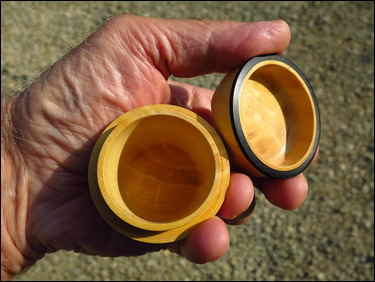 |
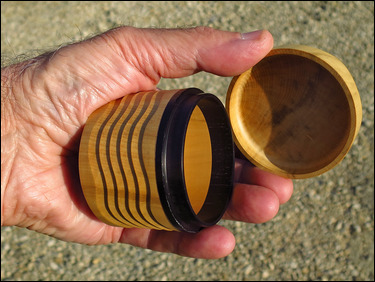 |
Describing the box shown below - Arthur said this is "My most ambitious one to date!" - made in boxwood and African blackwood - 110mm tall x 70mm diameter. The spiral fluting is achieved with a stair step drill. The fluted top was created using a spherical sliderest. The box is completed with a betel nut finial and rose engine decoration to the interior and base. |
|
 |
 |
 |
 |
| Ken Gateley has shared several projects he has been working on recently. |
|
| Just a small painted mushroom - made for fun! |
 |
| An egg table - used to store and display eggs (of course). This was made on request for a friend - who specified that it should hold 9 eggs! The item has a lot of router work (for the holes) and hand sanding for the finish. The table is made from Mahogany (the genuine stuff) - approx. 5/8" thick, is completed with an ash egg in a cup decoration and three turned feet. |
 |
These 'whale' shape chopping/ serving boards have been made as a set. They are all are 11" wide and are 12", 15" and 18" long - made in oak, and are 5/8" thick biscuit jointed and sanded on both sides - with a pyrographed eye and mouth and the finish is rapeseed oil. |
|
 |
 |
| Another request from a friend - a house number. Made in oak with 2 natural edges. The timber is - 3/4" thick by 10 1/2" long by by 7" wide. Pyrography was used for the number. Finished with several coats of Osmo UV Protection Oak Oil. |
 |
This large Cheese Board required a lot of hand sanding and router work. The board is made from a single piece of oak and is 23 1/2" long by 12" wide by 7/8" thick. The circular recesses for the glass domes - which are 6 1/2" diameter - were cut with a router, as were the cutouts for the twin cheese knives. The board is sanded smooth on both sides - so, the reverse side could be used for serving purposes - and is finished with rapeseed oil. |
|
 |
 |
Ken has also been busy on his lathe. This Dinner Tray was made for a neighbour - a replacement for a commercially purchased one that split in two! There is a central recess designed to hold dips (as in chips 'n' dips). The tray is made in olive ash - 12 1/2" diameter by 1 1/2" tall. The finish is rapeseed oil. |
|
 |
 |
This walnut bowl is 8 3/4" diameter by 3 5/8" high - it has been finished with microcrystalline wax. The hole 'appeared' during hollowing and can comfortably hold a £2 coin. Ken decided to leave this unfilled - as a natural feature of the wood. |
|
 |
 |
| Clive Alabaster says that whilst he is doing a bit of turning these days, it is not as much as he would like! This is largely due to the temporary lathe installation in his garage. He plans on getting a large workshop built next to his house and declares "then there'll be no stopping me". The walnut bowl is 250mm diameter by 100mm tall and is finished with Danish oil. The laburnum vase is 300mm tall by 70mm diameter. It has a glass tube insert, filled with water to hold a single rose! The finish is Danish oil with hi-gloss wax. The matching laburnum bonbon bowl is 120mm diameter by 60mm tall - finished with Danish oil and hi-gloss wax. |
|
 |
 |
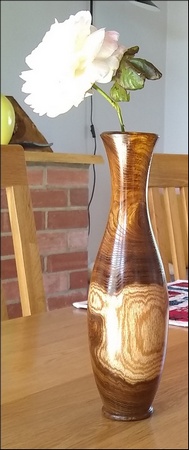 |
 |
| Harry has recently made a 'Wedding Ring Box' for a friend, who is scheduled to be the best man at a wedding. As a graphic designer the friend was very specific about the design and size of the box - and supplied a detailed drawing. Both halves of the box had to be equal - mirrored around the box joint, and the grooves around the outside are actually a (simplified) barcode of the bride and grooms initials. The box was made in ash - 50mm diameter by 106mm tall, with a spalted beech insert in the lid. The box was designed to be 'heavy' - so only minimal hollowing was done. A folded piece of felt will be put in the box base to hold and separate the wedding rings. The sharp corners and flat lid surface are as per specification. Finished with sanding sealer, buffed and then microcrystalline wax applied. Harry was pleased to supply the provenance of the timbers used. The ash came from a felled tree in his next-door neighbour's garden, and the spalted beech came from a section of wind-blown tree - rescued from Webbs Wood, near Brinkworth. Both (much larger) pieces were acquired in May 2012 (a genuine coincidence) and were 'air-dried' under the workbench. |
 |
 |
 |
 |
 |
A few more apples and pears - Made in various timbers - all with ebony stalks and buttons in the base. |
|
 |
|
 |
|
| Tim Mortimer has been engaged in a refurbishment project over the past few months. He has converted an old mangle into a printing press. Tim has fully described the process - a bit too long to show on this page - BUT, click HERE to display the document as a webpage. Here is a taster of the BEFORE and AFTER photos. |
|
|
Before
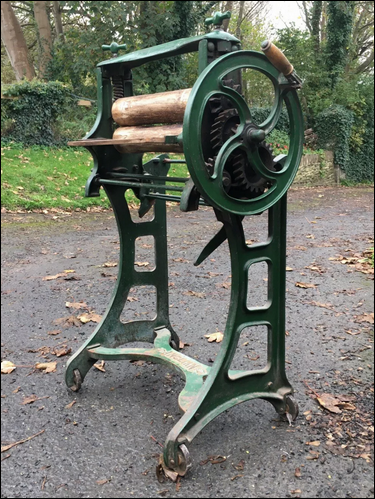 |
After
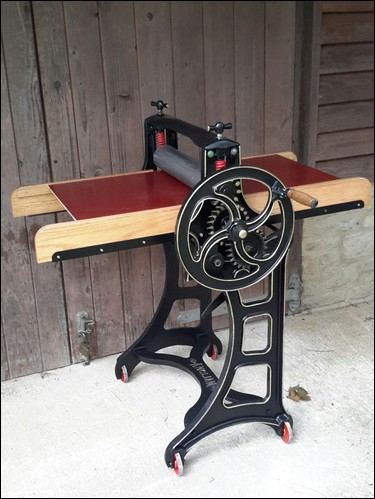 |
